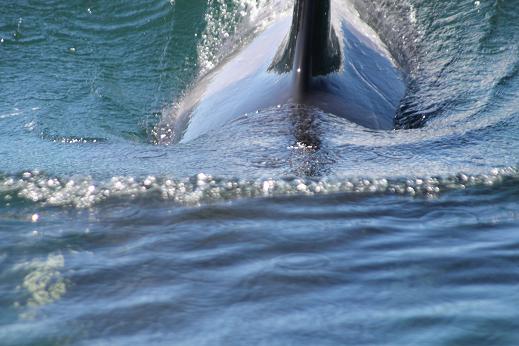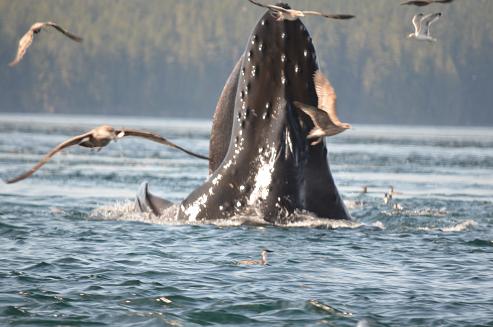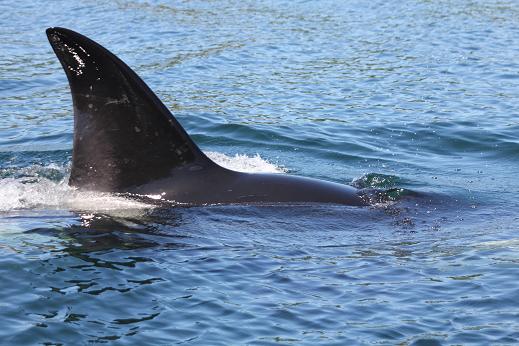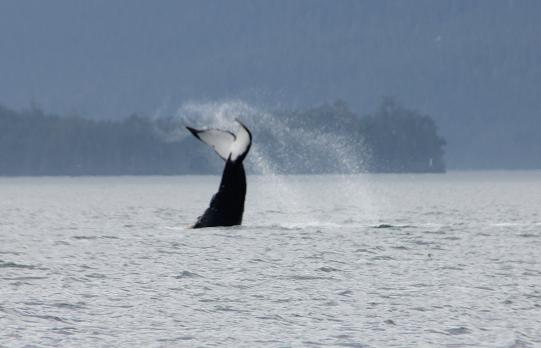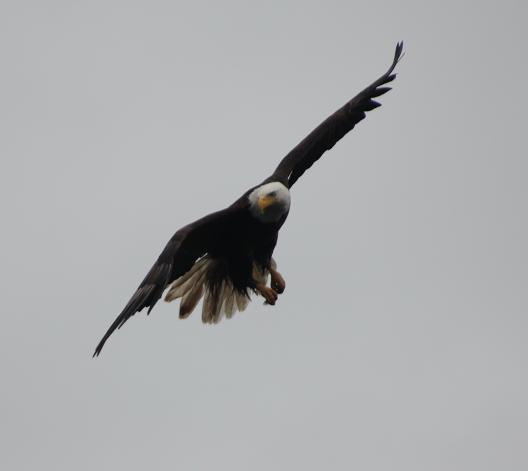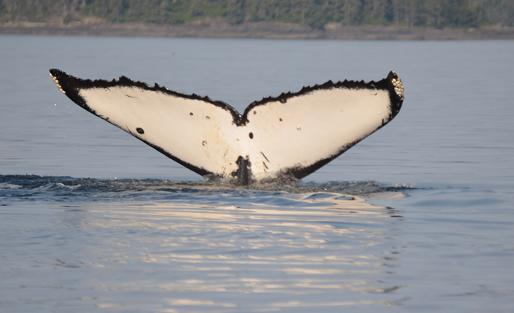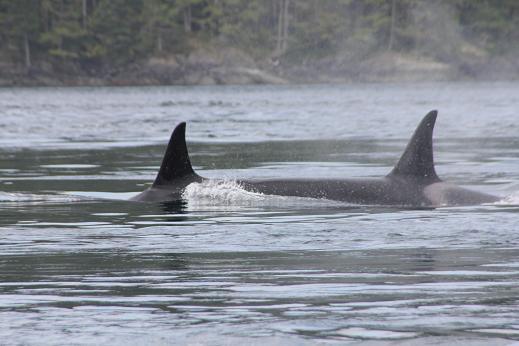Whale Watching
We’re not all about the bears, whales are abundant here too!
Killer whales and humpback whales are often seen during our wildlife tours. There are resident whales and transient whales that can be seen feeding and playing in our waters.
Humpback Whale Lunge Feeding
One method of feeding we often see with humpback whales is “Lunge Feeding”. The whale will lunge through a shoal of prey with mouth gaping open often exploding at the surface with both food and water. In this case the photo shows the top of the humpback’s head with its lower jaw hanging open. Humpback whales do not feed in the warmer climates of Hawaii and Mexico where they spend the winter so it makes sense that once they arrive in their feeding grounds, this will occupy most of their time. Humpback whales in our area will feed small, shoaling fish such as herring. They may eat up to 1,400 kg (3,000 lbs.) of food a day.
Killer Whales Visit
As with most wildlife viewing the best approach is often to sit and wait. On this particular whale watching tour from Grizzly Bear Lodge we arrived at the area of Johnstone Strait to start looking for orca and immediately located a pod of orca traveling along the shore. We stopped our boat, got out the cameras and let the orca come to us. As a guide for the lodge this is the best way to start a days trip and after some time with the orca we went on to watch stellar sealions, humpback whales lunge feeding, harbour seals, eagles and a few dall’s porpoise. All in all a full day.
Humpback Whale lobtailing
While on a whale watching tour from Grizzly Bear Lodge we came upon a humpback whale tail lobbing or lobtailing. Lobtailing is the act of a whale lifting its fluke (tail) out of the water and then bringing it down onto the surface of the water hard and fast in order to make a loud slap. In this picture it is an upside down lobbing where the top of the tail is hitting the surface so the whale is on its back. If you compare photos this is the same humpback from the Oct 18th posting. In this case a guest counted 38 consecutive slaps that is a lot of energy expelled and no one is sure why.
Not all viewing is wildlife (Not our boat)
This is what a guide calls “Job security”. When guest see this they are glad they are with a guide. To be fair this was a foggy morning and it is possible to pass close to this island just not on the side chosen by this driver. To give you confidence the guides at Grizzly Bear Lodge have each been working in the area for more than fifteen years.
Bald Eagle soaring overhead
Bald eagles are a common site on a Grizzly Bear Lodge tour day. Whether it is a tour to the grizzly bears, whales or a visit to the wild river eagles are found along the shore perched in trees or flying overhead. It takes a fast camera to obtain a good picture of a flying eagle as they to not pause for the photographer. The positive side to the abundance of eagles is that there are numerous opportunities for that “perfect” photo.
Photo used to ID Humpback Whales
Compared to the posting on October 1st this is the perfect photo to be used to identify a humpback whale. The underside of the fluke (tail) which shows the colour pattern, serrated edges and barnacles on the corners are unique to each whale. “Each individual humpback is given a unique alphanumeric identifier. Each identifier starts with BC to indicate that the animal was seen in British Columbian waters. Following the BC is an X, Y or Z, corresponding to the amount of white on the flukes and a number to identify the individual. BCX## contain approximately 0-20% white, BCY## have approximately 20-80% white and BCZ## have approximately 80-100% white. The catalogue is generally arranged in order of increasing white pigmentation. BCX flukes are further arranged into groups of similar appearance, and thus may not be in order of increasing white pigmentation.” Quote from the “Photographic Catalogue of Humpback Whales in British Columbia”.
Visiting Orca
At a first quick glance this might appear to be a “deformed orca” with two dorsal fins, but no it is only a calf and mother. Orcas travel in small groups or pods that are known by the identity of the oldest female in the pod. The pod structure for the orca is a matriarchy. This is a social organizational form in which the mother or oldest female heads the family or in this case the pod. The male orca stays with their mother all their life and breed outside the pod.
About to swim between islands
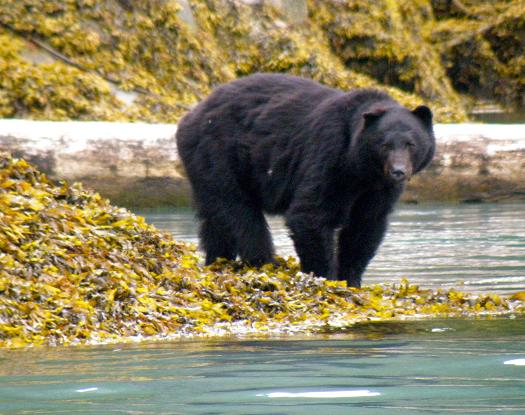 As we came along the shore on one of the whale watching trips we came upon this black bear stand at the edge of a small channel between two islands. It was not turning rocks and as we waited it went back up the beach into the bush. One of our other boasts was a about ten minutes behind us and when they got to this same point the bear was in the water swimming between islands. As in most wildlife viewing timing in important.
As we came along the shore on one of the whale watching trips we came upon this black bear stand at the edge of a small channel between two islands. It was not turning rocks and as we waited it went back up the beach into the bush. One of our other boasts was a about ten minutes behind us and when they got to this same point the bear was in the water swimming between islands. As in most wildlife viewing timing in important.
Humpback fluking close
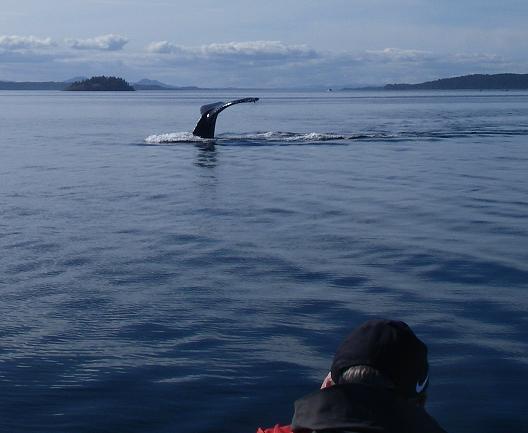 s a guide when I take photos in the boat I try to put things in perspective. For convenience I use a small Pentax OPI waterproof camera. This photo shows a guest taking a picture of a humpback whale fluking in the background. With the camera he was using and the closeness of the whale he has a good photo to take home and show his friends. This brings me to a word of caution I give all the guests in my boat: “Put down the camera and enjoy the experience”. If on your vacation, especially on wildlife tours, if you view everything through the lens of your camera you will miss more than half of the experience.
s a guide when I take photos in the boat I try to put things in perspective. For convenience I use a small Pentax OPI waterproof camera. This photo shows a guest taking a picture of a humpback whale fluking in the background. With the camera he was using and the closeness of the whale he has a good photo to take home and show his friends. This brings me to a word of caution I give all the guests in my boat: “Put down the camera and enjoy the experience”. If on your vacation, especially on wildlife tours, if you view everything through the lens of your camera you will miss more than half of the experience.
